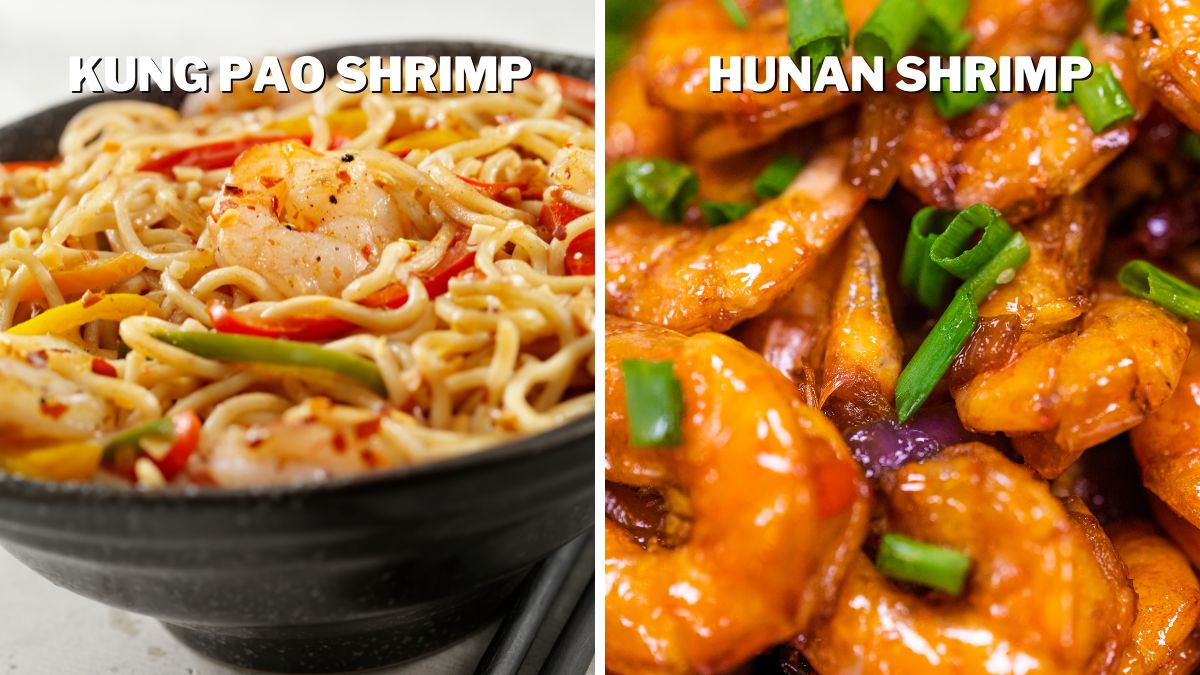Kung Pao Shrimp vs. Hunan Shrimp: Differences Explained

I am a sucker for seafood, and I love experimenting and trying seafood dishes from different cuisines. Therefore, I know how significant it is to know the differences between two seafood dishes originating from different cuisines. Both Kung Pao shrimp and Hunan shrimp are excellent, but they are not the same, and not knowing which is which may result in an unjust bad name for the dish, not to mention your disappointment. So, what are the differences between Kung Pao shrimp and Hunan shrimp?
Kung Pao shrimp has a spicy-sweet sauce, served with bell peppers, green onions, and peanuts, while Hunan shrimp has a spicier and savory sauce, served with broccoli, carrots, and snow peas, and the shrimp is usually deep-fried before stir-frying.
The thing with spicy dishes is that the levels of spiciness determine their overall flavors, so since you are going numb in your mouth, at least enjoy the dish. Kung Pao shrimp and Hunan shrimp are two delicacies you absolutely must try, but to enjoy them to the fullest, you need to know their features as they are significantly different. In this article, I will share my impressions of both and explain the aspects in which they differ.
Appearance
Kung Pao Shrimp and Hunan shrimp differ in terms of appearance, as well as taste, and serving styles.
So, the first difference you’ll notice is that the sauces are considerably different in thickness. The sauce in Kung Pao shrimp is traditionally thinner and has ingredients such as garlic, chili paste, and soy sauce. The sauce in Hunan shrimp is often thickened with cornstarch and features ingredients such as vinegar, soy sauce, and sugar.
Because they use different vegetables, Kung Pao and Hunan shrimp have different colors. While Kung Pao shrimp comes with bell peppers, green onions, and peanuts, Hunan shrimp comes with broccoli, carrots, and snow peas. The vegetables in Kung Pao shrimp are finer, while they are usually chunkier in Hunan shrimp.
Therefore, Kung Pao shrimp is the more colorful one with a more detailed texture, while Hunan shrimp is more understated, featuring mainly shades of green with a finer surface.
In summation, the main differences in appearance between Kung Pao shrimp and Hunan shrimp lie in the sauce, vegetables, and preparation method. The shrimp don’t play a role in the differences between these two dishes, as they are the same in both.
Taste

If you know anything about Chinese cuisine, you know that there are two cooking styles, Hunan and Szechuan. Kung Pao Shrimp comes from the Szechuan style, characterized by intense flavors and expressive spiciness, which is precisely what Kung Po tastes like. Although it makes my eyes tear up and my mouth numb, I love the liveliness and vibrancy of this dish.
It is a spicy stir-fried dish that usually features marinated shrimp, diced vegetables, most often bell peppers and onions, as well as a sauce made from soy sauce, vinegar, and chili paste.
The Kung Pao sauce is famous for its spicy and slightly sweet flavor, and it includes special Sichuan peppercorns that create a numbing sensation. It is typically garnished with peanuts or cashews, which add a crunchy texture and nutty flavor.
Hunan Shrimp is a stir-fried dish cooked in Hunan style. The Hunan style is also very spicy but is known as hotter than Szechuan, though this is mainly subjective.
Hunan shrimp typically includes large shrimp that are quickly stir-fried with a variety of vegetables, such as broccoli, snow peas, and mushrooms. Hunan sauce combines soy sauce, vinegar, sugar, garlic, and chili paste. It is savory, garlicky, spicy, and slightly sweet, and it is not as intense as the Kung Pao shrimp sauce.
Serving Style
Kung Pao shrimp traditionally comes with diced vegetables like bell peppers, zucchini, onions, and peanuts or cashews. It is often garnished with green onions and served over rice. The shrimp are cooked in a wok with a spicy sauce made from chili paste, soy sauce, and rice vinegar.
Hunan shrimp comes with a variety of vegetables, such as broccoli, carrots, and baby corn, in a spicy sauce served over steamed rice, but it can also be served without any.
The main difference in the serving styles of these two dishes lies in the ingredients in the sauce and the type of vegetables they include. Kung Pao shrimp typically has diced vegetables and nuts, while Hunan shrimp features broccoli and carrots.
Kung Pao shrimp comes with a garnish of green onions, while Hunan shrimp usually comes ungarnished.
